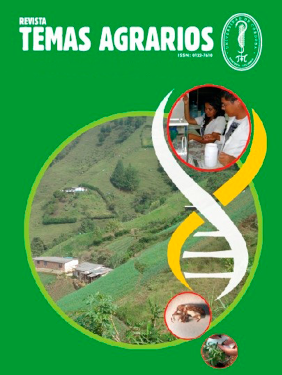Analysis of development textural activated carbon from zea mays
Analisis del desarrollo textural de carbones activados preparados a partir de zuro de maíz

This work is licensed under a Creative Commons Attribution-NonCommercial 4.0 International License.
Show authors biography
Some agricultural residues may be useful to produce adsorbent materials such as activated carbons. Such is the case of Zea mays, which was used as starting material in this research, this residue comes from the separation of the grains from the cob. For the preparation of activated carbon, initially free cob of corn kernels is carbonized at 400 ° C, subsequently carbonized were chemically activated with orthophosphoric acid, activated carbons obtained were modified with nitric acid and hydrogen peroxide preheating to 600 °C to observe the textural development. The solids were characterized by a final analysis for determining the surface area were conducted adsorption isotherms by the BET method using Micromeritics Gemini 2375. Activation with orthophosphoric acid increased carbon content and reduced oxygen content. Micropores area increased by treatment with HNO3 and H2 O2 from 278.3 m2 g-1hasta 401.7 m2g-1 and 446.4 m2 g-1, respectively, most of the total developed area corresponded to micropores. The pH coals generated was approximately 3, which was determined in aqueous solutions after washing with distilled water and these materials showed the same values in the COOH groups to 2.12 meq g-1.
Key word:
Article visits 1017 | PDF visits
Downloads
- Allen, S., Whitten, L. 2008. The production and characterization of activated coals: A
- Review. Asia-Pac. J. Chem. Eng. 6:231-261.
- Amalraj, A., Pius, A. 2014. Removal of selected basic dyes using
- activated carbon from tannery wastes. Sep. Sci. Technol. 49: 90- 100.
- Arpa, C., Basyilmaz, E., Bektas, S., Genc, O., & Yurum, Y. 2000. Cation exchange properties of low Turkish coals: removal of Hg, Cd and Pb from wastewater. Fuel Processing Technology 68(2):111-120.
- Berkowitz, N. 1957. On the differential thermal analysis of coal. Fuel 36:355-373
- Boehm, H.P. 1994. Some aspects of the surface chemistry of carbon blacks and other carbons. Carbon 32(5):759 -769.
- Burns, C.A., Cass, J., Harding, I., Russell, H. 1999. Adsorption of aqueous heavy metals onto carbonaceous substrates. Colloids and Surfaces A155:63-68.
- Castilla, M., López-Ramon, M.V., & CarrascoMarin,F. 2000. Changes in surface chemistry of activated carbons by wet oxidation.Carbon 38(14):1995-2001.
- Garoma, T., S., Shah, B., Badriyha. 2010. Removal of Cadmium, Copper, and Zinc from Aqueous Solution by Activated Carbon Impregnated with 8-Hydroxyquinoline. J Environ Sci Eng 4(5):14-21.
- González, J., Román, S., Encinar, J., Martínez, G. 2009. Pyrolysis of various biomass residues and char utilization for the production of activated carbons,” J. Anal. Appl. Pyrolysis, 85(1-2):134-141.
- Hsisheng, T., Yeh, T.S., & Hsu, L-Y. 1998. Preparation of Activated Carbon from Bituminous Coal with Phosphoric Acid Activation. Carbon 36(9):1387-1395.
- Huidobro, A., Pastor, A.C., & Rodríguez-Reinoso, F. 2000. Preparation of activated carbon cloth from viscous rayon. Part IV. Chemical activation.Carbon 39(3):389-398.
- Kim, D., Y. W., Jung, S., Kwon, J-W., Park. 2011. Adsorption of cadmium (II) from aqueous solutions by thiol-functionalized activated carbon. Water Sci. Technol.: Water Suppl. 11(1):61-66
- Kudo, K., & Yoshida,E. 1957. On the decomposition process of wood constituents in the course of carbonization. Journal of the Japanese Wood Research Society 3 (4):125-127.
- Li, Y., Q., Dua, X., Wang, P., Zhang, D., Wang, Z., Wang, Y., Xia. 2010. Removal of lead from aqueous solution by activated carbon prepared from Enteromorpha prolifera by zinc chloride activation. J Hazard Mat 183(1-3):583-589.
- López-Ramón, M.V., Stoeckli, F., MorenoCastilla, C., & Carrasco-Marín, F. 1999. On the characterization acidic and basic surface sites on carbons by various techniques. Carbon 37(8):1215- 1221.
- Mak, S., Tey, B., Cheah, K., Siew, W., Tan, K.2009. Porosity characteristics and pore developments of various particle sizes palmkernel shells activated carbon (PKSAC) andits potential applications. Adsorption 15: 507-519
- Marsh, H., Heintz, E.A., & Rodríguez-Reinoso, F.1997. Introduction to Carbon Technology.Capítulo 2.Universidad de Alicante.Alicante, España: Secretariado de Publicaciones.
- Navarrete, L., Giraldo, L., Baquero, M. 2005. Carbón activado: efecto del lavado con ácido sulfúrico del precursor lignocelulósico, cuesco de palma africana, sobre los procesos de carbonización y activación. Rev. Colombiana de Quím. 34:67-78.
- Ospina, V., Buitriago, R., Lopez, L. 2014. Preparación y caracterización de carbón activado a partir de torta de higuerilla. Tecno Lógicas 17(32):75-84.
- Primera, O., Colpas, F., Meza, E., Fernandez, R. 2011. Carbones activados a partir de bagazo de caña de azúcar y zuro de maíz para la adsorción de cadmio y plomo. Rev. acad. colomb. cienc. exact. fi. nat. 35(136): 387.396.
- Rodríguez-Reinoso, F. & Molina-Sabio,M. 1998. Carbones activados a partir de materiales lignocelulósicos. Química e Industria 45(9):563-571.
- SCFI (Secretaria de Comercio Fomento Industrial). 1982. Norma mexicana NMX-B-158-1982, Métodos para determinar el azufre total en la muestra de carbón y coque. http://200.77.231.100/work/normas/ nmx/1982/nmx-b-158-1982.pdf.
- Song, X., Liu, L., Chenga, & Y., Qu. 2010. Surface modification of coconut-based activated carbon by liquid-phase oxidation and its effects on lead ion adsorption. Desalination 255(1- 3):78-83.
- Tongpoothorn, W., Sriuttha, P., Homchan, S.,Chanthai, C., Ruangviriyacha. 2011. Preparation of activated carbon derived from Jatropha curcas fruit shell by simple thermochemical activation and characterization of their physicochemical properties. Chem Eng Res Des 89(3):335- 340.
- Valix, M., Cheung, W.H., Zhang, K. 2008. Textural and surface chemistry of activated bagasse and its role in the removal of chromium ions from solution. Adsorption 14:711-718.
- Wu Z, Zhao D. 2011. Ordered mesoporous materials as adsorbents. Chem Commun; 47:3332–8.
- Yu C, Fan X, Yu L, Bandosz TJ, Zhao Z, Qiu J. 2013. Adsorptive removal of thiophenic compounds from oils by activated carbon modifid with concentrated nitric acid. Energy Fuel .27:1499–505.
- Zhang, H., Yan, Y., Yang, L. 2010. Preparation of activated carbon from sawdust by zinc chloride activation. Adsorption 16:161-166.




















